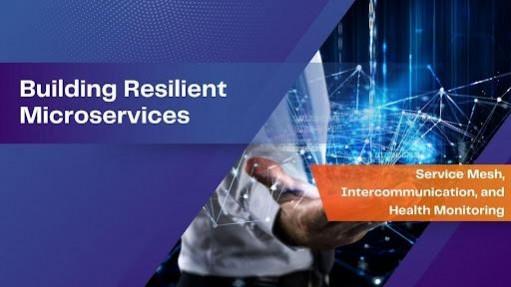
Microservices architecture has emerged as a vital strategy in cloud-native application development, offering a modular approach to building resilient and scalable systems. In this article, Deepa Madhavan explores the key components that contribute to robust microservices design: the integration of service mesh technology for secure and efficient communication, the implementation of effective intercommunication strategies to maintain system integrity, and the adoption of comprehensive health monitoring practices. These elements are crucial in addressing the complexities inherent in distributed systems, providing seamless communication, enhanced security, and improved observability. This holistic approach empowers organizations to develop high-performing, adaptable applications in today's dynamic computing environments.
Enhancing Resilience with Service Mesh
Service mesh is a crucial technology for managing microservices communication, security, and observability by introducing an infrastructure layer that separates complex inter-service communication from application logic. Central to this technology is the use of lightweight proxies, known as the "sidecar" pattern, which are deployed alongside application code to intercept and manage network traffic between services, enabling centralized configuration and monitoring. Key features include traffic management through sophisticated load balancing and routing techniques like canary deployments, fault tolerance with circuit breakers and retries for rerouting traffic during failures, simplified service discovery for automatic connectivity without code changes, and secure communications via mutual TLS (mTLS) encryption. By abstracting communication complexities, service mesh enables the deployment of secure, scalable applications, providing a centralized control plane for consistent security and traffic management, making it an indispensable tool for modern microservices ecosystems.
Strategies for Efficient Microservices Intercommunication
Effective communication between microservices is crucial for maintaining system integrity and performance, and several intercommunication strategies have been developed to ensure scalable and reliable data exchange. API gateways serve as entry points, managing and routing requests to appropriate services while enforcing security policies, and offering benefits like intelligent routing, protocol translation, centralized authentication, rate limiting, and analytics. Event-driven communication allows services to react asynchronously to events, enhancing scalability and fault tolerance by decoupling services, reducing the risk of cascading failures, and promoting independent operation. Asynchronous messaging patterns further support this by enabling non-blocking communication, thereby improving system responsiveness and scalability through methods like message queues for task distribution and publish-subscribe systems for one-to-many communication. Together, these strategies ensure that microservices interact in a decoupled and scalable manner, facilitating smooth operations and rapid development.
Monitoring and Maintaining Microservices Health
Continuous monitoring and proactive maintenance are essential for the reliability of microservices, especially as system complexity increases. A comprehensive monitoring approach includes distributed tracing, which tracks requests across services to identify bottlenecks and troubleshoot performance issues. Metrics collection gathers crucial performance data, such as request and error rates, and resource usage, providing insights through real-time and historical analysis. Log aggregation centralizes logs from various services, streamlining analysis and debugging, while health checks regularly assess the status of each service to ensure overall system reliability. Circuit breakers prevent cascading failures by temporarily disabling malfunctioning services, isolating problems, and allowing time for recovery. Modern observability platforms integrate these techniques, offering automated, real-time anomaly detection and rapid issue resolution. Implementing these practices demands a shift toward an observability-driven development culture, where developers take on the responsibility for monitoring and maintaining their services, ensuring a robust and responsive microservices environment.
In conclusion, building resilient microservices demands a multifaceted approach that leverages advanced technologies and best practices to tackle the inherent complexities of distributed systems. Deepa Madhavan highlights the significance of integrating service mesh technology to manage inter-service communication, adopting efficient intercommunication strategies like API gateways and event-driven communication, and implementing comprehensive monitoring frameworks for proactive maintenance. These elements are vital for creating scalable and robust microservices ecosystems capable of adapting to rapidly changing business needs. By embracing these innovations, organizations can ensure their cloud-native applications remain reliable, secure, and efficient, fostering long-term success in an ever-evolving digital landscape.

















